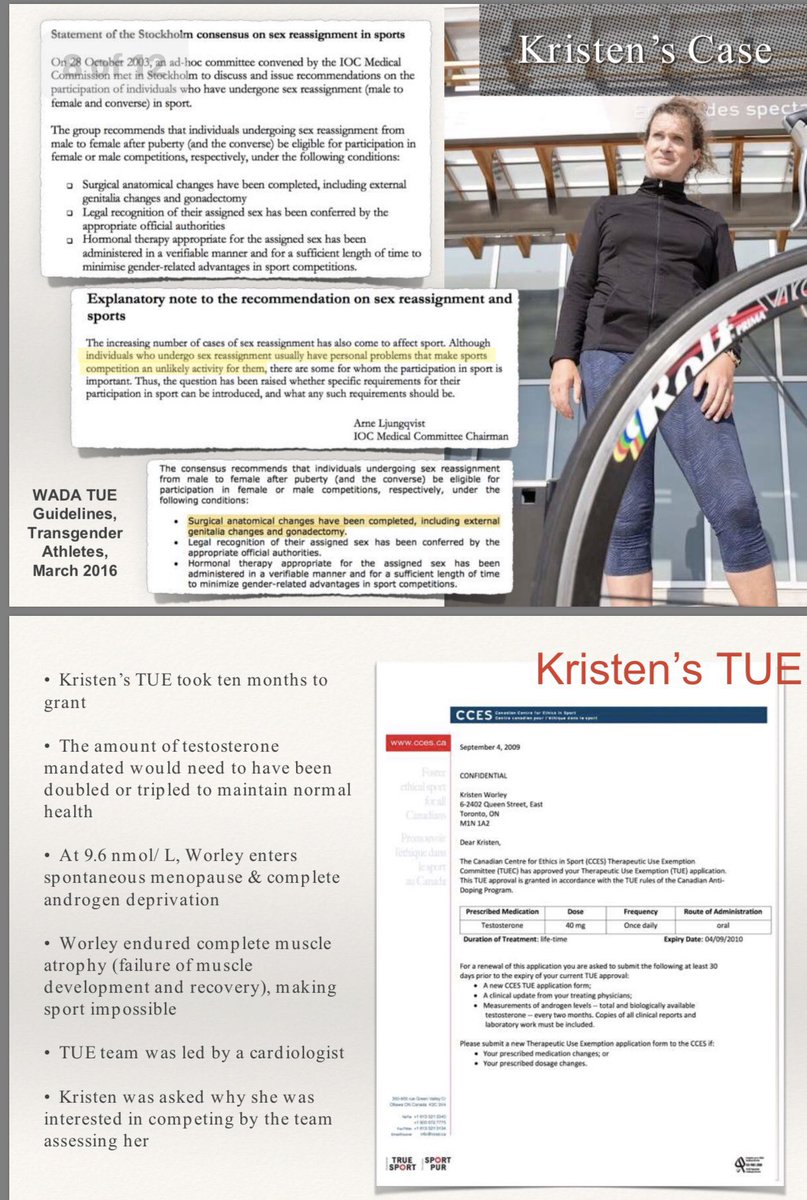
The complicated truth about testosterone’s effect on athletic performance.
One study of professional male triathletes found no relationship between testosterone levels and performance
tandfonline.com/doi/abs/10.310…
One study of professional male triathletes found no relationship between testosterone levels and performance
tandfonline.com/doi/abs/10.310…

Another, looking at professional cyclists, found the same lack of correlation.
thieme-connect.com/products/ejour…
thieme-connect.com/products/ejour…
Yet another, comparing cyclists, weightlifters, and controls to each other on a cycling test, found a negative correlation between testosterone levels and performance.
tandfonline.com/doi/full/10.10…
tandfonline.com/doi/full/10.10…
A study of teenage weightlifters found no relationship between boys’ testosterone levels and their performance, and a negative correlation among the girls—meaning they performed better when their testosterone was lower.
journals.humankinetics.com/view/journals/…
journals.humankinetics.com/view/journals/…
Some studies have even found mixed or opposing results within their own findings. One found that sprinters seem to get an advantage from testosterone, while other runners didn’t.
biorxiv.org/content/10.110…
biorxiv.org/content/10.110…
Another came to the conclusion that it helped female track athletes, but not male ones.
bjsm.bmj.com/content/51/17/…
bjsm.bmj.com/content/51/17/…
There’s also differences in results depending on what type of strength you look at—endurance strength seems to decrease with higher testosterone levels, while maximum strength generally only increases.
Complicating all of this is the fact that elite athletes’ testosterone levels vary quite a lot. One analysis found that 25% of elite male athletes have testosterone levels below what the IAAF consider the lower limit for men.
clindiabetesendo.biomedcentral.com/articles/10.11…
clindiabetesendo.biomedcentral.com/articles/10.11…
What’s more, it wasn’t the athletes in less strength- or speed-oriented sports. Some of the events with the most men below the limit were powerlifting, rowing, track and field, ice hockey, and rowing.
Basketball players and alpine skiers had some of the highest levels.
That all seems to imply, at that high testosterone isn’t a universal performance booster.
That all seems to imply, at that high testosterone isn’t a universal performance booster.
The mixed results might explain why even broad review articles find opposing results. Reviews have suggested both that there’s not enough evidence to enforce any upper testosterone limit in women,
tandfonline.com/doi/full/10.10…
tandfonline.com/doi/full/10.10…
Sports relies on abilities that are fundamentally unfair. Just as tiny gymnasts do better than tall ones, there are myriad factors that give some athletes advantages over others.
Testosterone should be ‘de-gendered.’ It is a hormone present in both genders, which is why continuity of gender should trump levels of testosterone.
It is far too simplistic to say that the only difference between men and women is their testosterone levels. If you’re going to look at performance differences, you also have to look at sociological ones.
There are almost certainly biological differences that mean men will always on ave outperform women to some degree, but teenage girls are much less likely to compete in sports at school than boys and are given generally worse facilities.
Male athletes are paid much better than female ones on the whole. Holt says these and other factors mean “there are a whole load of sociological reasons that may also drive men to coach and be driven to achieve at a high level beyond testosterone.
Besides, the idea that a naturally occurring variation in some women’s bodies is somehow unfair doesn’t mesh with how much we exalt male athletes with unusual abilities.
Michael Phelps’ muscles produce half the lactic acid of a normal person, enabling him to push himself for much longer without fatigue.
Finnish cross-country skier Eero Mäntyranta has an inherited mutation that increases his red blood cells’ oxygen-carrying capacity by 25 to 50 percent, which is the genetic equivalent of doping.
bjsm.bmj.com/content/37/3/1…
bjsm.bmj.com/content/37/3/1…
Sports are inherently unfair, and while there have to be some regulations to account for true cheating, it seems like a double standard to demonize women for the same kind of natural advantages that we appreciate in men.
And to simplify the entire debate down to a single (albeit important) hormone ignores a great deal of biology and sociology. We should celebrate those biological differences. 

@threadreaderapp please unroll
• • •
Missing some Tweet in this thread? You can try to
force a refresh












